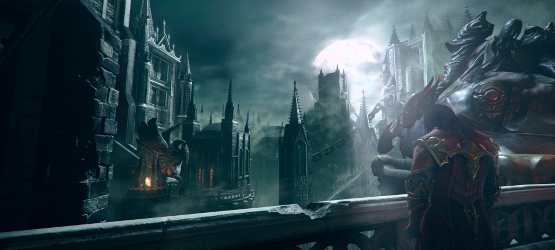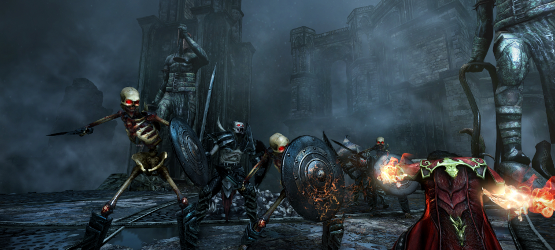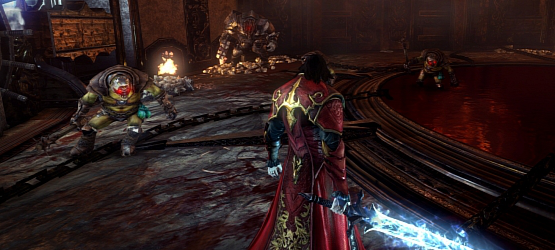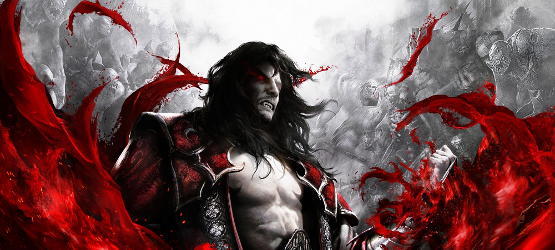Modern men are caught between lots of duality. Men are trapped between apology promotions and home-guiding reliance on women. They’re even slaves to business, yet clearly aware of the dangerous grasp money has on everyday freedoms. Obviously, someone’s gotta wake Dracula up once every thousand years to embody this sad personality crisis. I say that because in this Castlevania game, the player is Dracula. This isn’t a quest to take the original vampire down. In the last game, Gabriel, the OG Belmont, destroyed the four lords of shadow and defeated Satan to keep the world safe from harm.
Now, Dracula lives in a massive castle and probably has one of those rooms with like a hundred TV screens in one wall like Richie Rich, so I’m lost on what he’s so upset about. Caught between life and death in a totally modern city, complete with secret corporate goo-factories, a massive castle, and tons of demons to bash, Dracula just wants to sleep. He can’t go without being woken up and reminded that he’s a thorn in God’s side and Satan’s chosen prince of darkness. With sweet release knocking on his big wooden doors, it’s up to Dracula to decide where the Castlevania franchise goes next. Unfortunately, no matter which path the big bad vampire decides to walk, he’ll find a disjointed, altogether misguided adventure with as many high points as low.
Right away, Dracula is caught in between old habits and new. One of my favorite elements in the first Lords of Shadow brought back the destruction of Dracula’s interior decorating, searching for health pick ups and the like. Candles and barrels are everywhere in this sequel’s modern city, especially as it wraps around and transitions between Dracula’s castle and other locales. Dracula might not like breaking his own stuff, but remember that this vampire has the heart of a Belmont in him. Concept art is also mixed in with pickups, so get to grunting and breaking everything in the game. Still, this –Vania seems like a poor emulation of the first Batman Arkham game, though not as memorable. It took me a few trips to start recognizing paths between big areas, but by the time I finished the game I didn’t care to go back anyway.

Early on, it seems like Lords of Shadow 2 drops the ball on several gameplay opportunities and mechanics. A low-level boss during a train ride features a brief sequence overlooking the massive city, but it’s quickly taken away and whisked into a tunnel where mediocrity ensues. At first I thought this was a cool way to introduce a mid-level baddie I’ll fight throughout the adventure. The latter part of that was true, but the fight quickly got boring without the big vista behind it. Sometimes the game will astound with incredible visuals, but others look washed out with murky textures. A lot of the painted scenes in the first game benefitted from a fixed camera angle, and while (like in the train sequence described above) brief flashes of this still exist in Lords of Shadow 2, everything else feels messy.
Something was lost in the transition between fixed and free-camera systems that seems as careless as a pistol to the gut in a room crowded with TV cameras. There are certainly elements of the castle that look gorgeous and even the surrounding city has few presentation and design bright spots, but the setbacks feel like an even bigger raspberry to fans once Dracula has made it through every stealth sequence in the game’s narrative. They’re each designed to teach the player something about a particular ability, but in the end each feels haphazard and wasteful of the momentum gained from combat.
In stealth, Dracula gets all of his powers taken away and he’s forced to sneak around Golgoth guards or later in the game against a boss character. Instead, Dracula has to rely on projectiles, a swarm of bats that can distract enemies, possession enemies bodies, and a mist ability introduced much later.

Unfortunately for players, none of these sequences offered very clear instructions and it was far too easy to fail or get stuck thinking about a room in one way. I got frustrated on more than a few occasions and had to walk away, even though the combat is compelling enough on its own to play through the entire adventure in one sitting. Eventually, Gabriel Belmont’s old friend Zobek, voiced by Patrick Stewart, barks orders and sends Dracula dashing here and there with his personal guard and the two solve some awful co-op puzzles together.
At this point, it seems like Mercury Steam threw everything they had at the wall and actually kept some of the less entertaining game mechanics. There’s a core of incredible combat and exploration, but at some point it becomes exhausted and buried with stealth, AI-based co-op puzzles, and transforming into a freaking rat. I have never known Dracula to turn into a rat. Maybe a bat? Never a rat. What the hell, Konami?
Further, there’s a very extended and awkward neck-biting boss fight with Camilla and Gabriel’s wife and Dracula spends a bunch of time looting and destroying a few corporate chemical factories. Our hero frequently warps back and forth between the gothic-techno city and the straight-up gothic castle, but in the end it just left me confused. If only I could put the all-out 3D combat down. Dracula might suck at stealth and story-telling, but Castlevania’s whipping has never felt so good.

Dracula gets the Shadow Whip, Chaos Gauntlets, and Void Sword early in the game, and switching between the three refills magic, deals heavy damage, and recovers health (respectively). That is all instantly satisfying. You start the game with all of Dracula’s abilities, which is an assuredly disastrous sign as the rest of the game attests, but once you get everything back it’s easy to defeat every demon that throws you a dirty look. Here’s a combo I learned to use frequently:
As soon as a battle starts, I threw down an Hour Glass power up. This slows the motion of every enemy you hit and gives you souls for every strike, allowing me to mop up a bunch of low level grunts and collect a bunch of level-up credits right away. If I took any damage, I switched to Void Sword, but more often than not I could switch to Chaos Gauntlets instead. The Shadow Whip’s range lets you hit more people with the Hour Glass effect, but the Gauntlets do way more damage when focused on a single target.
From there I could lift enemies by hitting jump right after an attack, I could throw knives or explosive blasts with Chaos energy, or I could switch back to the Shadow Whip to build the focus meter up and reap more energy to fill Chaos and Void bars. Once you get the Mist ability, you get an entirely new method of avoiding enemy attacks. I always recommend dashing over sticking it out to attack, but with Mist you can pull R2 instead of L2 and disappear right as the massive sword drops.
Overall, I’d say the state of modern men through Dracula’s eyes is pretty bleak. The battle with Camilla doesn’t exactly insult women, but it’s a weak spot of gameplay gussied into a poorly produced joke that, man or woman, no one is going to really understand. The stealth sequences are so bad I could nearly throw out the entire experience. I can’t, but I almost did. Next time Dracula gets back in that coffin, how about we bury it in the graveyard like we were supposed to. Only Igarashi has the right spells to resurrect this one.
Review copy provided by publisher. For information on scoring, please read our Review Policy here.
-
Leveling up Shadow Whip, Chaos Gauntlets, and Void Sword
-
All Combat, some level and story design
-
All Stealth, some level and story design
-
Some weak bosses








